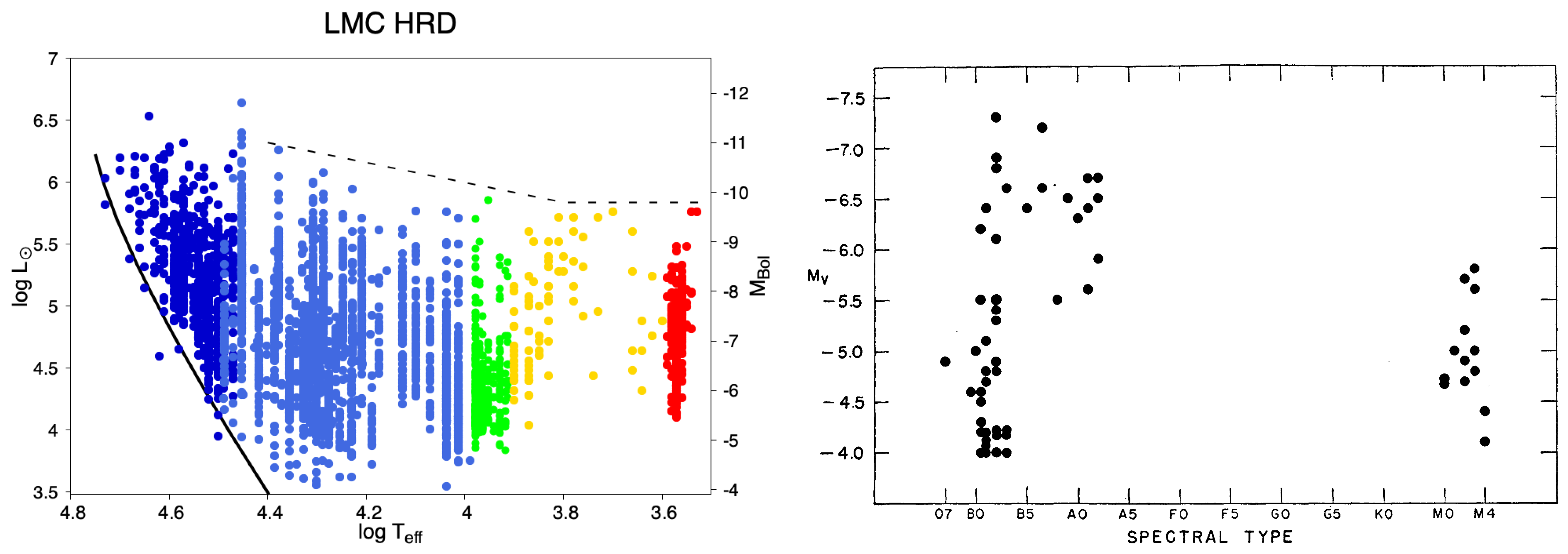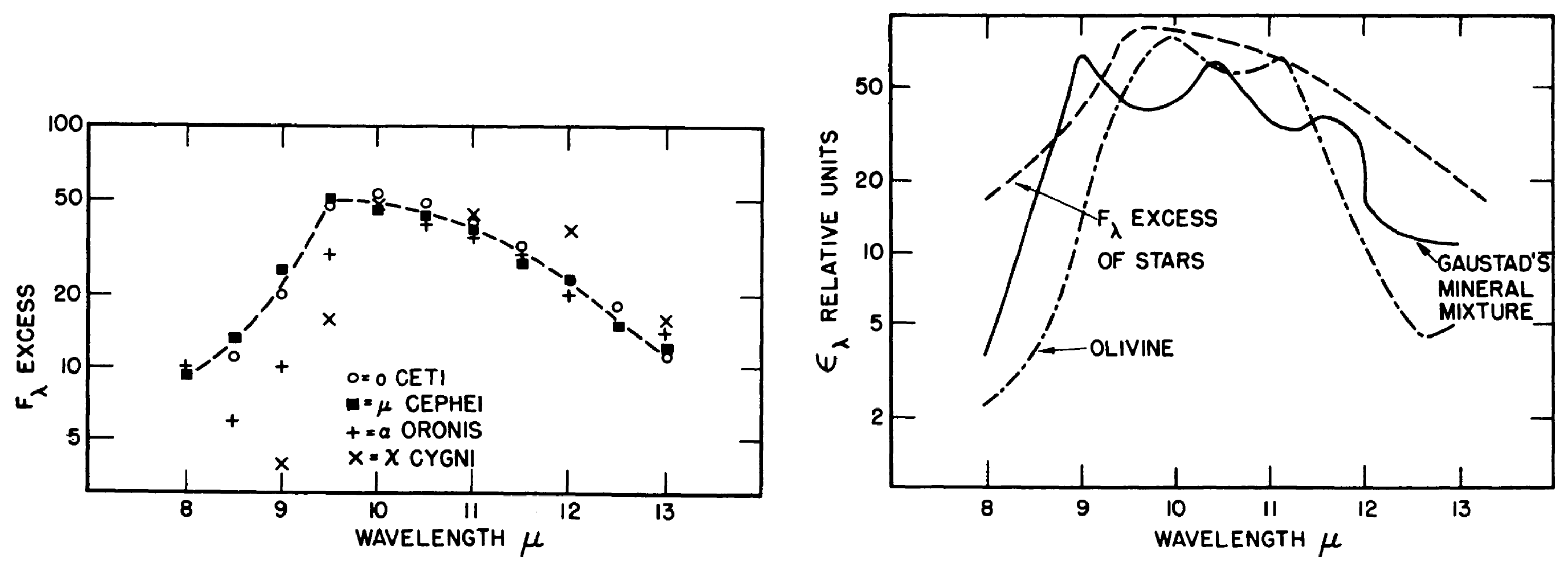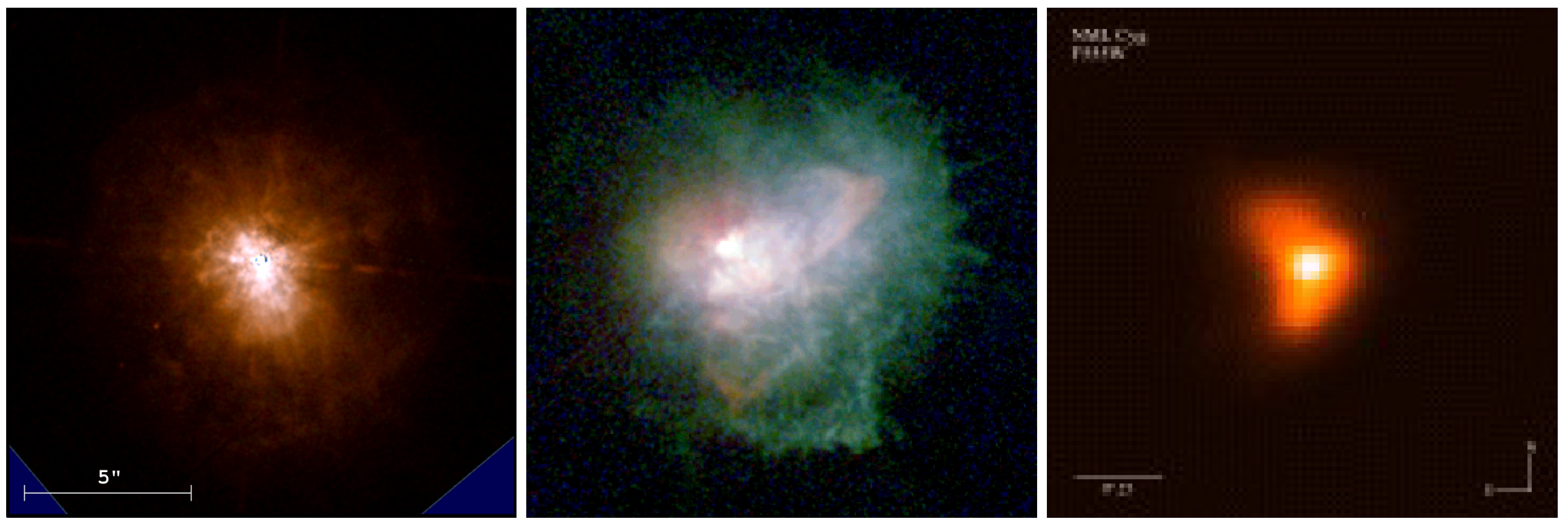Red Supergiants—The Other Side of the H-R Diagram
Abstract
1. Introduction
2. Red Supergiants on the H-R Diagram
3. So What Is a Red Supergiant?
3.1. Physical Properties
3.2. Variability
3.3. Binarity
4. Circumstellar Ejecta and Mass Loss
5. The Final State—Supernovae
6. Current Questions—The Red Supergiant Problem, Episodic Mass Loss, and Post Red Supergiants
Funding
Conflicts of Interest
Abbreviations
| HRD | Hertzsprung–Russell Diagram, H-R Diagram |
| RSG | red supergiant |
| SED | spectral energy distribution |
References
- Levesque, E. The Astrophysics of Red Supergiants; Institute of Physics Publishing: Bristol, UK, 2017; ISBN 978-0-7503-1330-8. [Google Scholar]
- Martin, J.C.; Humphreys, R.M. A Census of the Most Luminous Stars. I. The Upper HR Diagram for the Large Magellanic Cloud. Astron. J. 2023, 166, 214–225. [Google Scholar] [CrossRef]
- Bidelman, W.P. The M-Type Supergiant Members of the Double Cluster in Perseus. Astrophys. J. 1947, 105, 492–496. [Google Scholar] [CrossRef]
- Humphreys, R.M.; Davidson, K. Studies of Luminous stars in Nearby Galaxies. III—Comments on the Evolution of the Most Massive Stars in the Milky Way and the Large Magellanic Cloud. Astrophys. J. 1979, 232, 409–420. [Google Scholar] [CrossRef]
- McCarthy, M.F. Fr. Secchi and Stellar Spectra. Pop. Astron. 1950, 58, 153–168. [Google Scholar]
- Cannon, A.J.; Pickering, E.C. The Henry Draper Catalog. HA 1918–1924, 91–99. [Google Scholar]
- Morgan, W.W.; Keenan, P.C.; Kellman, E. An Atlas of Stellar Spectra, with an Outline of Spectral Classification; University of Chicago Press: Chicago, IL, USA, 1943. [Google Scholar]
- Flower, P.J. Transformations from Theoretical H-R Diagrams to C-M Diagrams. Astron. Astrophys. 1977, 54, 31–39. [Google Scholar]
- Flower, P.J. Transformations from Theoretical Hertzsprung-Russell Diagrams to Color-Magnitude Diagrams: Effective Temperatures, B-V Colors, and Bolometric Corrections. Astrophys. J. 1996, 469, 355–365. [Google Scholar] [CrossRef]
- Levesque, E.M.; Massey, P.; Olsen, K.A.G.; Plez, B.; Josselin, E.; Maeder, A.; Meynet, G. The Effective Temperature Scale of Galactic Red Supergiants: Cool, but Not as Cool as We Thought. Astrophys. J. 2005, 628, 973–985. [Google Scholar] [CrossRef]
- Levesque, E.M.; Massey, P.; Olsen, K.A.G.; Plez, B.; Meynet, G.; Maeder, A. The Effective Temperatures and Physical Properties of Magellanic Cloud Red Supergiants: The Effects of Metallicity. Astrophys. J. 2006, 645, 1102–1117. [Google Scholar] [CrossRef]
- Plez, B.; Brett, J.M.; Nordland, A. Spherical opacity sampling model atmospheres for M-giants. I. Techniques, data and discussion. Astron. Astrophys. 1992, 258, 551–571. [Google Scholar]
- Gustafsson, B.; Edvardsson, B.; Eriksson, K.; Mizuno-Wiedner, M.; Jørgensen, U.G.; Plez, B. A Grid of Model Atmospheres for Cool Stars. In Proceedings of the ASP Conference Proceedings, Tuebingen, Germany, 8–12 April 2002; Hubeny, I., Mihalas, D., Werner, K., Eds.; Stellar Atmosphere Modeling. Astronomical Society of the Pacific: San Francisco, CA, USA, 2003; pp. 331–334. [Google Scholar]
- Gustafsson, B.; Edvardsson, B.; Eriksson, K.; Jørgensen, U.G.; Nordlund, Å.; Plez, B. A grid of MARCS model atmospheres for late-type stars. I. Methods and general properties. Astron. Astrophys. 2008, 486, 951–970. [Google Scholar] [CrossRef]
- Davies, B.; Kudritzki, R.-P.; Plez, B.; Trager, S.; Lançon, A.; Gazak, Z.; Bergemann, M.; Evans, C.; Chiavassa, A. The Temperatures of Red Supergiants. Astrophys. J. 2013, 767, 3–23. [Google Scholar] [CrossRef]
- Gordon, M.S.; Humphreys, R.M.; Jones, T.J. Luminous and Variable Stars in M31 and M33: The Yellow and Red Supergiants and Post=Red Supergiant Evolution. Astrophys. J. 2016, 825, 50–67. [Google Scholar] [CrossRef]
- Norris, R.P.; Beltran, Y.; Lucero, K.; Frothingham, D. An Optical Interferometric Look at Red Supergiants. Bull. AAS 2023, 55, 163.11. [Google Scholar]
- Norris, R.P.; Baron, F.R.; Monnier, J.D.; Paladini, C.; Anderson, M.D.; Martinez, A.O.; Schaefer, G.H.; Che, X.; Chiavassa, A.; Connelley, M.S.; et al. Long Term Evolution of Surface Features on the Red Supergiant AZ Cyg. Astrophys. J. 2021, 919, 124–145. [Google Scholar] [CrossRef]
- Glass, I.S. Infrared observations of late-type supergiants in the Magellanic Clouds. Mon. Not. R. Astron. Soc. 1979, 186, 317–326. [Google Scholar] [CrossRef]
- Feast, M.W.; Catchpole, R.M.; Carter, B.S.; Roberts, G. A period-luminosity relation for supergiant red variables in the LMC. Mon. Not. R. Astron. Soc. 1980, 193, 377–380. [Google Scholar] [CrossRef]
- Massey, P.; Levesque, E.M.; Olsen, K.A.G.; Plez, B.; Skiff, B.A. HV 11423: The Coolest Supergiant in the SMC. Astrophys. J. 2007, 660, 301–310. [Google Scholar] [CrossRef]
- Humphreys, R.M.; Lockwood, G.W. Spectroscopic and Photometric Changes in the Peculiar Infrared Star VX Sagittarius. Astrophys. J. 1972, 172, L59–L62. [Google Scholar] [CrossRef]
- Sana, H.; de Mink, S.E.; de Koter, A.; Langer, N.; Evans, C.J.; Gieles, M.; Gosset, E.; Izzard, R.G.; Le Bouquin, J.-B.; Schneider, F.R.N. Binary Interaction Dominates the Evolution of Massive Stars. Science 2012, 337, 444–453. [Google Scholar] [CrossRef]
- Neuhäuser, R.; Torres, G.; Mugrauer, M.; Neuhäuser, D.L.; Chapman, J.; Luge, D.; Cosci, M. Colour evolution of Betelgeuse and Antares over two millennia, derived from historical records, as a new constraint on mass and age. Mon. Not. R. Astron. Soc. 2022, 516, 693–719. [Google Scholar] [CrossRef]
- Kudritzki, R.P.; Reimers, D. On the absolute scale of mass-loss in red giants. II. Circumstellar absorption lines in the spectrum of alpha Sco B and mass-loss of alpha Sco A. Astron. Astrophys. 1978, 70, 227–239. [Google Scholar]
- Cowley, A.P. The VV Cephei Stars. Publ. Astron. Soc. Pac. 1969, 81, 297–331. [Google Scholar] [CrossRef]
- Bauer, W.H.; Stencel, R.E.; Neff, D.H. Twelve years of IUE spectra of the interacting binary VV Cephei. Astron. Astrophys. Suppl. Ser. 1991, 90, 175–183. [Google Scholar]
- Bauer, W.H.; Bennett, P.D. The Ultraviolet Spectrum of VV Cephei Out of Eclipse. Publ. Astron. Soc. Pac. 2000, 112, 31–49. [Google Scholar] [CrossRef]
- Wright, K.O. The System of VV Cephei Derived from an Analysis of the H-alpha Line. J. R. Astron. Soc. Can. 1977, 71, 152–193. [Google Scholar]
- Bennett, P.D.; Bauer, W.H. The Special Case of VV Cephei. In Giants of Eclipse: The ζ Aurigae Stars and Other Binary Systems; Ake, T.B., Griffin, E., Eds.; Springer International Publishing: Cham, Switzerland, 2015; p. 85. ISBN 978-3-319-09197-6. [Google Scholar]
- Goldberg, J.A.; Joyce, M.; Molnar, L.A. A Buddy for Betelgeuse: Binarity as the Origin of the Long Secondary Period in α Orionis. Astrophys. J. 2024, 977, 35–55. [Google Scholar] [CrossRef]
- MacLeod, M.; Blunt, S.; De Rosa, R.J.; Dupree, A.K.; Granzer, T.; Harper, G.M.; Huang, C.D.; Leiner, E.M.; Loeb, A.; Nielsen, E.L.; et al. Radial Velocity and Astrometric Evidence for a Close Companion to Betelgeuse. Astrophys. J. 2025, 978, 50–81. [Google Scholar] [CrossRef]
- Neugebauer, G.; Leighton, R.B. Two-Micron Sky Survey, a Preliminary Catalog; NASA Special Publication: Washington, DC, USA, 1969. [Google Scholar]
- Woolf, N.J.; Ney, E.P. Circumstellar Infrared Emission from Cool Stars. Astrophys. J. 1969, 155, 181–184. [Google Scholar] [CrossRef]
- Humphreys, R.M.; Strecker, D.W.; Ney, E.P. Spectroscopic and Photometric Observations of M Supergiants in Carina. Astrophys. J. 1972, 172, 75–88. [Google Scholar] [CrossRef]
- Neugebauer, G.; Habing, H.J.; van Duinen, R.; Aumann, H.H.; Baud, B.; Beichman, C.A.; Beintema, D.A.; Boggess, N.; Clegg, P.E.; de Jong, T.; et al. The Infrared Astronomical Satellite (IRAS) mission. Astrophys. J. 1984, 278, L1–L6. [Google Scholar] [CrossRef]
- Elias, J.H.; Frogel, J.A.; Humphreys, R.M. M supergiants in the Milky Way and the Magellanic Clouds: Colors, spectral types, and luminosities. Astrophys. J. Suppl. Ser. 1985, 57, 57–131. [Google Scholar] [CrossRef]
- Skrutskie, M.F.; Cutri, R.M.; Stiening, R.; Weinberg, M.D.; Schneider, S.; Carpenter, J.M.; Beichman, C.; Capps, R.; Chester, T.; Elias, J.; et al. The Two Micron All Sky Survey (2MASS). Astron. J. 2006, 131, 1163–1183. [Google Scholar]
- Blain, A.; Lonsdale, C.; Cutri, R.; WISE Team. The WISE mission: An Atlas for Luminous Galaxy Evolution. Bull. Am. Astron. Soc. 2005, 37, 1393. [Google Scholar]
- de Jager, C.; Nieuwenhuijzen, H.; van der Hucht, K.A. Mass Loss Rates in the Hertzsprung-Russell Diagram. Astron. Astrophys. Suppl. Ser. 1988, 72, 259–289. [Google Scholar]
- van Loon, J.T.; Cioni, M.-R.L.; Zijlstra, A.A.; Loup, C. An Empirical Formula for the Mass-Loss Rates of Dust-Enshrouded Red Supergiants and Oxygen-Rich Asymptotic Giant Branch Stars. Astron. Astrophys. 2005, 438, 273–289. [Google Scholar] [CrossRef]
- Mauron, N.; Josselin, E. The Mass-Loss Rates of Red Supergiants and the de Jager Prescription. Astron. Astrophys. 2011, 526, 156–170. [Google Scholar] [CrossRef]
- Vink, J.S.; Subhahit, G.N. Exploring the Red Supergiant wind kink. A Universal mass-loss concept for massive stars. Astron. Astrophys. 2023, 678, L3–L7. [Google Scholar] [CrossRef]
- Kwok, S. Radiation Pressure on Grains as a Mechanism for Mass Loss in Red Giants. Astrophys. J. 1975, 198, 583–591. [Google Scholar] [CrossRef]
- van Loon, J.T.; Marshall, J.R.; Cohen, M.; Matsuura, M.; Wood, P.R.; Yamamura, I.; Zijlstra, A.A. Very Large Telescope three micron spectra of dust-enshrouded red giants in the Large Magellanic Cloud. Astron. Astrophys. 2006, 447, 971–989. [Google Scholar] [CrossRef]
- Gilliland, R.L.; Dupree, A.K. First Image of the Surface of a Star with the Hubble Space Telescope. Astrophys. J. 1996, 463, L29–L32. [Google Scholar] [CrossRef]
- Anugu, N.; Baron, F.; Gies, D.R.; Lanthermann, C.; Schaefer, G.H.; Shepard, K.A.; Brummelaar, T.T.; Monnier, J.D.; Kraus, S.; Le Bouquin, J.-B.; et al. The Great Dimming of the Hypergiant Star RW Cephei: CHARA Array Images and Spectral Analysis. Astron. J. 2023, 166, 78–89. [Google Scholar] [CrossRef]
- Anugu, N.; Gies, D.R.; Roettenbacher, R.M.; Monnier, J.D.; Montargés, M.; Mérand, A.; Baron, F.; Schaefer, G.H.; Shepard, K.A.; Kraus, S.; et al. Time Evolution Images of the Hypergiant RW Cephei during the Rebrightening Phase Following the Great Dimming. Astrophys. J. 2024, 973, L5–L24. [Google Scholar] [CrossRef]
- Yang, M.; Bonanos, A.Z.; Jiang, B.; Zapartas, E.; Gao, J.; Ren, Y.; Lam, M.I.; Wang, T.; Maravelias, G.; Gavras, P.; et al. Evolved Massive Stars at Low-metallicity. V. Mass-loss Rate of Red Supergiant Stars in the Small Magellanic Cloud. Astron. Astrophys. 2023, 676, 84–100. [Google Scholar] [CrossRef]
- Antoniadis, K.; Bonanos, A.; de Wit, S.; Zapartas, E.; Munoz-Sanchez, G.; Maravelias, G. Establishing a Mass-loss rate Relation for Red Supergiants in the Large Magellanic Cloud. Astron. Astrophys. 2024, 686, 88–105. [Google Scholar] [CrossRef]
- Humphreys, R.M.; Helmel, G.; Jones, T.J.; Gordon, M.S. Exploring the Mass-loss Histories of the Red Supergiants. Astron. J. 2020, 160, 145–165. [Google Scholar] [CrossRef]
- Dupree, A.K.; Strassmeier, K.G.; Matthews, L.D.; Uitenbroek, H.; Calderwood, T.; Granzer, T.; Guinan, E.F.; Leike, R.; Montargès, M.; Richards, A.M.S.; et al. Spatially Resolved Ultraviolet Spectroscopy of the Great Dimming of Betelgeuse. Astrophys. J. 2020, 899, 68–79. [Google Scholar] [CrossRef]
- Humphreys, R.M.; Davidson, K.; Richards, A.M.S.; Ziurys, L.M.; Jones, T.J.; Ishibashi, K. The Mass-loss History of the Red Hypergiant VY CMa. Astron. J. 2021, 161, 98–108. [Google Scholar] [CrossRef]
- Humphreys, R.M.; Richards, A.M.S.; Davidson, K.; Singh, A.P.; Decin, L.; Ziurys, L.M. The Hidden Clumps in VY CMa Uncovered by ALMA. Astron. J. 2024, 167, 94–106. [Google Scholar] [CrossRef]
- Humphreys, R.M.; Jones, T.J. Episodic Gaseous Outflows and Mass Loss from Red Supergiants. Astron. J. 2022, 163, 103–109. [Google Scholar]
- Vlemmings, W.H.T.; Diamond, P.J.; van Langevelde, H.J. Circular Polarization of Water Masers in the Circumstellar Envelopes of Late Type Stars. Astron. Astrophys. 2002, 394, 589–602. [Google Scholar] [CrossRef]
- Zwicky, F. Supernovae. In Stellar Structure–Stars and Stellar Systems Vol. VIII; Aller, L.H., McLaughlin, D.B., Eds.; University of Chicgo Press: Chicago, IL, USA, 1965; p. 367. [Google Scholar]
- Minkowski, R. Spectra of Supernovae. Publ. Astron. Soc. Pac. 1941, 53, 224–225. [Google Scholar] [CrossRef]
- Barbon, R.; Dallaporta, N.; Perinott, M.; Sussi, M.G. On the lower mass limit for implosion type Supernovae. Mem. Soc. Astronom. Ital. 1965, 36, 127–150. [Google Scholar]
- Barbaro, G.; Dallaporta, N.; Summa, G. On the Presumed presupernova Stage for type II Supernovae. Comm. Konkoly Obs. 1969, 65, 41–50. [Google Scholar]
- Barbon, R.; Ciatti, F.; Rosino, L. Photometric Properties of Type II Supernovae. Astron. Astrophys. 1979, 72, 287–292. [Google Scholar]
- Maeder, A. The most massive stars evolving to red supergiants—Evolution with mass loss, WR stars as post-red supergiants and pre-supernovae. Astron. Astrophys. 1981, 99, 97–107. [Google Scholar]
- Smartt, S.J.; Eldridge, J.J.; Crockett, R.M.; Maund, J.R. The death of massive stars—I. Observational constraints on the progenitors of Type II-P supernovae. Mon. Not. R. Astron. Soc. 2009, 395, 1409–1437. [Google Scholar]
- Smartt, S.J. Observational Constraints on the Progenitors of Core-Collapse Supe rnovae: The Case for Missing High-Mass Stars. Publ. Astron. Soc. Aust. 2015, 32, e002. [Google Scholar] [CrossRef][Green Version]
- Beasor, E.M.; Davies, B. The Evolution of Red Supergiants to Supernova in NGC 2100. Mon. Not. R. Astron. Soc. 2016, 463, 1269–1283. [Google Scholar] [CrossRef]
- Davies, B.; Beasor, E.M. The Initial Masses of the Red Supergiant Progenitors to Type II Supernovae. Mon. Not. R. Astron. Soc. 2018, 474, 2116–2128. [Google Scholar] [CrossRef]
- Walmswell, J.J.; Eldridge, J.J. Circumstellar Dust as a Solution to the Red Supergiant Supernova Progenitor Problem. Mon. Not. R. Astron. Soc. 2012, 419, 2054–2062. [Google Scholar] [CrossRef]
- Kilpatrick, C.D.; Foley, R.J. The Dusty Progenitor Star of the Type II Supernova 2017eaw. Mon. Not. R. Astron. Soc. 2018, 481, 2536–2547. [Google Scholar] [CrossRef]
- Gerke, J.R.; Kochanek, C.S.; Stanek, K.Z. The Search for Failed Supernovae with the Large Binocular Telescope: First Candidates. Mon. Not. R. Astron. Soc. 2015, 450, 3289–3305. [Google Scholar] [CrossRef]
- Adams, S.M.; Kochanek, C.S.; Gerke, J.R.; Stanek, K.Z.; Dai, X. The Search for Failed Supernovae with the Large Binocular Telescope: Confirmation of a Disappearing Star. Mon. Not. R. Astron. Soc. 2017, 468, 4968–4981. [Google Scholar] [CrossRef]
- Humphreys, R.M. Comments on the Progenitor of NGC 6946-BH1. Res. Notes AAS 2019, 3, 164–167. [Google Scholar] [CrossRef]
- De, K.; MacLeod, M.; Jencson, J.E.; Lovegrove, E.; Antoni, A.; Kara, E.; Kasliwal, M.M.; Lau, R.M.; Loeb, A.; Masterson, M.; et al. The Disappearance of a Massive Star Marking the Birth of a Black Hole in M31. arXiv 2024, arXiv:2410.14778. [Google Scholar]
- Humphreys, R.M.; Jones, T.J.; Polomski, E.; Koppelman, M.; Helton, A.; McQuinn, K.; Gehrz, R.D.; Woodward, C.E.; Wagner, R.M.; Gordon, K.; et al. M33’s Variable A: A Hypergiant Star More Than 35 YEARS in Eruption. Astron. J. 2006, 131, 2105–2113. [Google Scholar] [CrossRef]
- Tiffany, C.; Humphreys, R.M.; Jones, T.J.; Davidson, K. The Morphology of IRC+10420’s Circumstellar Ejecta. Astron. J. 2010, 140, 339–349. [Google Scholar] [CrossRef]
- Shenoy, D.; Humphreys, R.M.; Jones, T.J.; Marengo, M.; Gehrz, R.D.; Helton, L.A.; Hoffmann, W.F.; Skemer, A.J.; Hinz, P.M. Searching for Cool Dust in the Mid-to-far Infrared: The Mass-loss Histories of the Hypergiants μ Cep, VY CMa, IRC+10420, and ρ Cas. Astron. J. 2016, 151, 51–65. [Google Scholar] [CrossRef]
- Humphreys, R.M.; Smith, N.; Davidson, K.; Jones, T.J.; Gehrz, R.T.; Mason, C.G.; Hayward, T.L.; Houck, J.R.; Krautter, J. HST and Infrared Images of the Circumstellar Environment of the Cool Hypergiant IRC + 10420. Astron. J. 1997, 114, 2778–2788. [Google Scholar] [CrossRef]
- Smith, N.; Humphreys, R.M.; Davidson, K.; Gehrz, R.D.; Schuster, M.T.; Krautter, J. The Asymmetric Nebula Surrounding the Extreme Red Supergiant VY Canis Majoris. Astron. J. 2001, 121, 1111–1125. [Google Scholar] [CrossRef]
- Schuster, M.T.; Humphreys, R.M.; Marengo, M. The Circumstellar Environments of NML Cygni and the Cool Hypergiants. Astron. J. 2006, 131, 603–611. [Google Scholar] [CrossRef]
- Maund, J.R.; Fraser, M.; Ergon, M.; Pastorello, A.; Smartt, S.J.; Sollerman, J.; Benetti, S.; Botticella, M.-T.; Bufano, F.; Danziger, I.J.; et al. The Yellow Supergiant Progenitor of the Type II Supernova 2011dh in M51. Astrophys. J. 2011, 739, 37L–42L. [Google Scholar] [CrossRef]
- Van Dyk, S.D.; Li, W.; Cenko, S.B.; Kasliwal, M.M.; Horesh, A.; Ofek, E.O.; Kraus, A.L.; Silverman, J.M.; Arcavi, I.; Filippenko, A.V.; et al. The Progenitor of Supernova 2011dh/PTF11eon in Messier 51. Astrophys. J. 2011, 741, L28–L33. [Google Scholar] [CrossRef]
- Van Dyk, S.D.; Zheng, W.; Clubb, K.I.; Filippenko, A.V.; Cenko, S.B.; Smith, N.; Fox, O.D.; Kelly, P.L.; Shivvers, I.; Ganeshalingam, M. The Progenitor of Supernova 2011dh has Vanished. Astrophys. J. 2013, 772, L32–L37. [Google Scholar] [CrossRef]





| Parameter | Range | Comment |
|---|---|---|
| Sp Type | K5–M4.5 | |
| Teff | 3900–3400 K | |
| Luminosity | MV ≈ −4 to −8 (mag) | |
| MBol −5.5 to −9.7 (mag) | ||
| Log L/L⊙ 4.5 to 5.7 | ||
| Radius | ≈1.5 to 7 AU | from CHARA interferometry |
| 300 to 1500 R⊙ | ||
| Mass | 9 to ≈40 M⊙ | based on evolutionary tracks |
Disclaimer/Publisher’s Note: The statements, opinions and data contained in all publications are solely those of the individual author(s) and contributor(s) and not of MDPI and/or the editor(s). MDPI and/or the editor(s) disclaim responsibility for any injury to people or property resulting from any ideas, methods, instructions or products referred to in the content. |
© 2025 by the author. Licensee MDPI, Basel, Switzerland. This article is an open access article distributed under the terms and conditions of the Creative Commons Attribution (CC BY) license (https://creativecommons.org/licenses/by/4.0/).
Share and Cite
Humphreys, R.M. Red Supergiants—The Other Side of the H-R Diagram. Galaxies 2025, 13, 25. https://doi.org/10.3390/galaxies13020025
Humphreys RM. Red Supergiants—The Other Side of the H-R Diagram. Galaxies. 2025; 13(2):25. https://doi.org/10.3390/galaxies13020025
Chicago/Turabian StyleHumphreys, Roberta M. 2025. "Red Supergiants—The Other Side of the H-R Diagram" Galaxies 13, no. 2: 25. https://doi.org/10.3390/galaxies13020025
APA StyleHumphreys, R. M. (2025). Red Supergiants—The Other Side of the H-R Diagram. Galaxies, 13(2), 25. https://doi.org/10.3390/galaxies13020025






